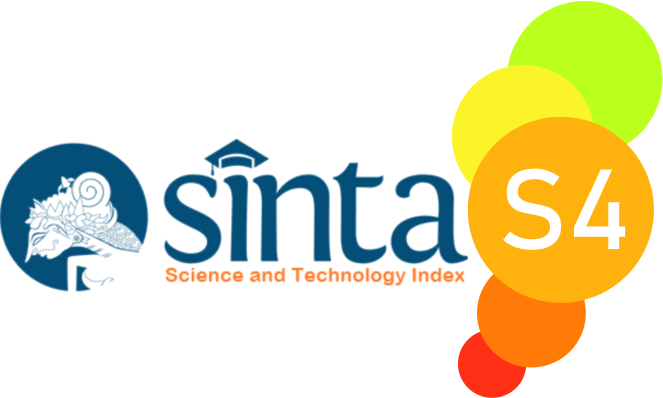Lexical Variation Used by Muslim Speech Community in Saren Jawa
A Sociolinguistic Study
Abstract
Language variations emerge the production of new lexicons regularly. Lexical variations can be found in ethnic places since the community stands with their strong culture and tradition. Saren Jawa is a Muslim village in the middle of Hinduism majority. This village has language phenomenon where the Muslim speech community tends to use Balinese to interact each other. This study aimed to analyse the lexical variations used by Muslim speech community in Saren Jawa. This study applied sociolinguistic study with natural approach in form of qualitative research. The study focused on five language domains namely, family, neighbourhood, friendship, school, and religion. In collecting the data, participatory and non-participatory observation were used in five language domains. The lexical variations were compared by using Swadesh list and categorized into their types. The result found a number of 108 lexical differences out of 207 standard lexicons compared to Swadesh. Neighbourhood domain committed the most lexical variations, while the fewest obtained by the school and religion domains. There were four types of lexical variations categorized in this study, including semasiological, onomasiological, formal and contextual variations. Therefore, the Muslim speech community in Saren Jawa still maintains their language as how they communicate among Balinese area.
References
Basuki, Hartati, U., & Mukhlis. (2019). Language Variation Choice in Social Interaction among Bilingual Speech Community. International Conference on Technology, Education and Science, ISSN: 978-, 71–77.
Buson, L., Nardy, A., Muller, D., & Chevrot, J. P. (2018). The Sociolinguistic Repetition Task: A New Paradigm for Exploring the Cognitive Coherence of Language Varieties. Topics in Cognitive Science, 10(4), 803–817. https://doi.org/10.1111/tops.12380
Carrió-Pastor, M. L., & Muñiz-Calderón, R. (2015). Identification and causes of lexical variation in Chinese Business English. English Today, 31(1), 10–15. https://doi.org/10.1017/S0266078414000480
Dameria Purba, Sinurat, B., & Herman. (2020). Utilizing Instagram Social Media on Language Style: An Analysis to Teenagers as Millennial Generations in Their Captions. Anglophile Journal, 1(1), 1–12.
Geeraerts, D., Grondelaers, S., & Bakema, P. (1994). The Structure of Lexical Variation Meaning, Naming, and Context. In R. Dirven & R. W. Langacker (Eds.), Mouton de Gruyter. https://doi.org/10.1515/9783110811933.607
Hudson, R. A. (1996). Sociolinguistics. Cambridge university press.
Kamal, K. D., & Hanafi, S. M. (2022). Lexical Variants in Pashto: A Comparative Study Accompanied in Paktia and Nangrahar. International Journal for Research in Applied Sciences and Biotechnology, 9(1), 66–73. https://doi.org/10.31033/ijrasb.9.1.6
Kartikasari, E., Larasati, D. A., Rais, W. A., & Warto. (2020). Lexical and phonological differences in javanese in probolinggo, surabaya, and ngawi, indonesia. Journal of Language Teaching and Research, 11(2), 231–241. https://doi.org/10.17507/jltr.1102.11
Latifah, L., Saddhono, K., & Wardhani, N. E. (2017). Language Variation Background in Social Context of Community Utterances in Central Java-West Java, Majenang. Lingua Didaktika: Jurnal Bahasa Dan Pembelajaran Bahasa, 11(1), 95. https://doi.org/10.24036/ld.v11i1.7675
Miles, M. B., & Huberman, A. M. (1994). Qualitative data analysis: An expanded sourcebook. Sage.
Nanda, S., Erito, P., Kunci, K., Dialek, :, Ngkalongan, D., & Pekalongan, B. J. (2020). A Sociolinguistic Study Of The Variety Of Ngkalongan Dialect Javanese Spoken By Pekalongan People. Journal of English Literature, Linguistic, and Education, 2(1), 22–30.
Natan, L. (2023). Loanwords Analysis of Java Island City and Region’s Name on the立地成 (Lìdì Chéng) Site. Journey: Journal of English Language and Pedagogy, 6(1), 92-98. https://doi.org/10.33503/journey.v6i1.2592.
Njeyiyana, S. (2022). Lexical variation and change in SASL : a case study of a Western Cape school-lect by.
Pura, C. M., Gustilo, L., & Biermeier, T. (2022). How the Pandemic Fuels Linguistic Change: Lexical Innovations in L1 and L2 English Varieties. GEMA Online Journal of Language Studies, 22(1), 80–109. https://doi.org/10.17576/gema-2022-2201-05
Purwaningsih, A. (2020). Sound Alteration on Malay Language Enclave in Jembrana. 8, 239–243.
Sormin, R. K. (2021). THE USE OF LANGUAGE VARIATION IN SIMALUNGUN PARAPAT : A SOCIOLINGUISTICS. 1(1), 37–41.
Sugiyono. (2016). Memahami Penelitian Kualitatif. Alfabeta.
Tuckman, B. W., & Harper, B. E. (2012). Conducting educational research. Rowman & Littlefield Publishers.
Widayati, D., & Lubis, R. (2018). The Inherited Proto-Austronesian Vowel Phonemes in Karo Language. Ijllc, 3(4), 5–7.
Wirata, I. W. (2021). A Critical Analysis of Language Variation In The Traditional Art Market Senggigi and Sade ( Sociolinguistic Studies ). 4(1), 90–106.
Copyright (c) 2023 I Komang Widiasmara, I Nyoman Adi Jaya Putra, Ni Luh Putu Sri Adnyani

This work is licensed under a Creative Commons Attribution-ShareAlike 4.0 International License.

Journey: Journal of English Language and Pedagogy by http://ejurnal.budiutomomalang.ac.id/index.php/journey/index is licensed under a Creative Commons Attribution-ShareAlike 4.0 International License.






